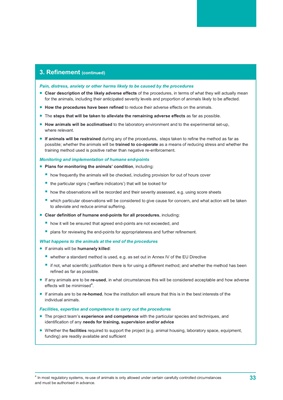
33
3. Refinement (continued)
Pain, distress, anxiety or other harms likely to be caused by the procedures
Clear description of the likely adverse effects of the procedures, in terms of what they will actually mean
for the animals, including their anticipated severity levels and proportion of animals likely to be affected.
How the procedures have been refined to reduce their adverse effects on the animals.
The steps that will be taken to alleviate the remaining adverse effects as far as possible.
How animals will be acclimatised to the laboratory environment and to the experimental set-up,
where relevant.
If animals will be restrained during any of the procedures, steps taken to refine the method as far as
possible; whether the animals will be trained to co-operate as a means of reducing stress and whether the
training method used is positive rather than negative re-enforcement.
Monitoring and implementation of humane end-points
Plans for monitoring the animals" condition, including:
how frequently the animals will be checked, including provision for out of hours cover
the particular signs ("welfare indicators") that will be looked for
how the observations will be recorded and their severity assessed, e.g. using score sheets
which particular observations will be considered to give cause for concern, and what action will be taken
to alleviate and reduce animal suffering.
Clear definition of humane end-points for all procedures, including:
how it will be ensured that agreed end-points are not exceeded, and
plans for reviewing the end-points for appropriateness and further refinement.
What happens to the animals at the end of the procedures
If animals will be humanely killed:
whether a standard method is used, e.g. as set out in Annex IV of the EU Directive
if not, what scientific justification there is for using a different method; and whether the method has been
refined as far as possible.
If any animals are to be re-used, in what circumstances this will be considered acceptable and how adverse
effects will be minimised4
.
If animals are to be re-homed, how the institution will ensure that this is in the best interests of the
individual animals.
Facilities, expertise and competence to carry out the procedures
The project team"s experience and competence with the particular species and techniques, and
identification of any needs for training, supervision and/or advice
Whether the facilities required to support the project (e.g. animal housing, laboratory space, equipment,
funding) are readily available and sufficient
4 In most regulatory systems, re-use of animals is only allowed under certain carefully controlled circumstances
and must be authorised in advance.